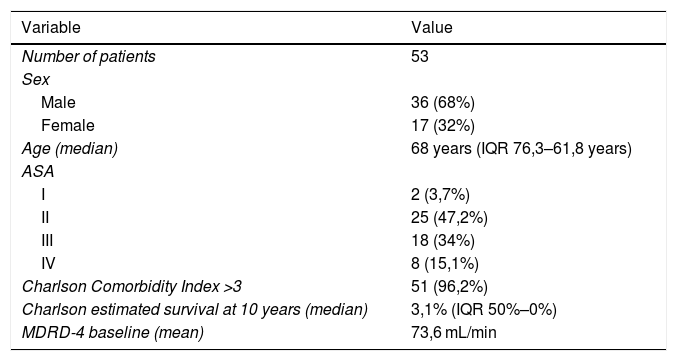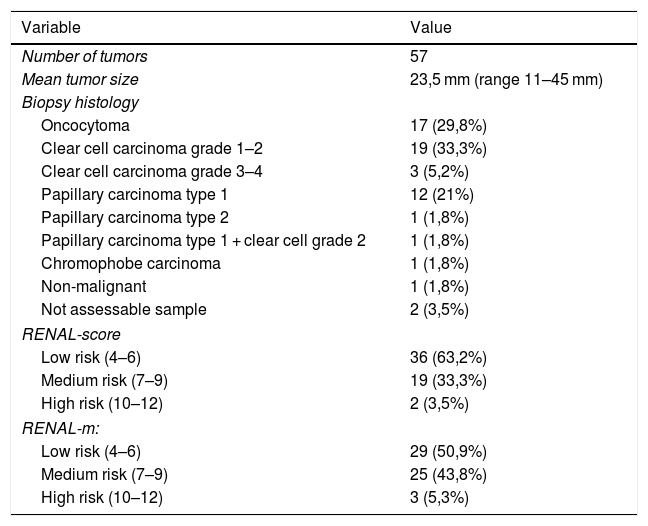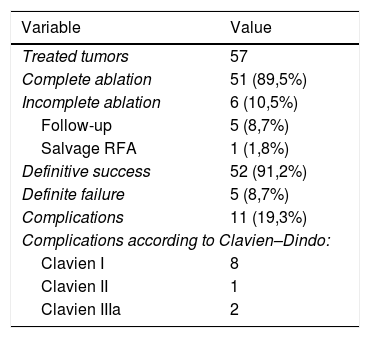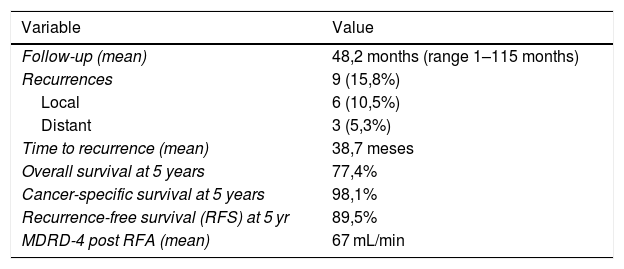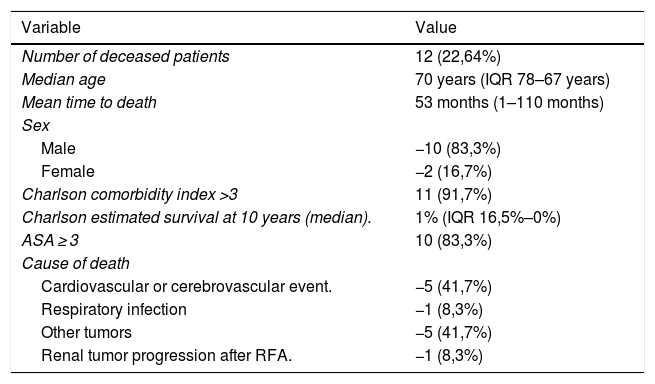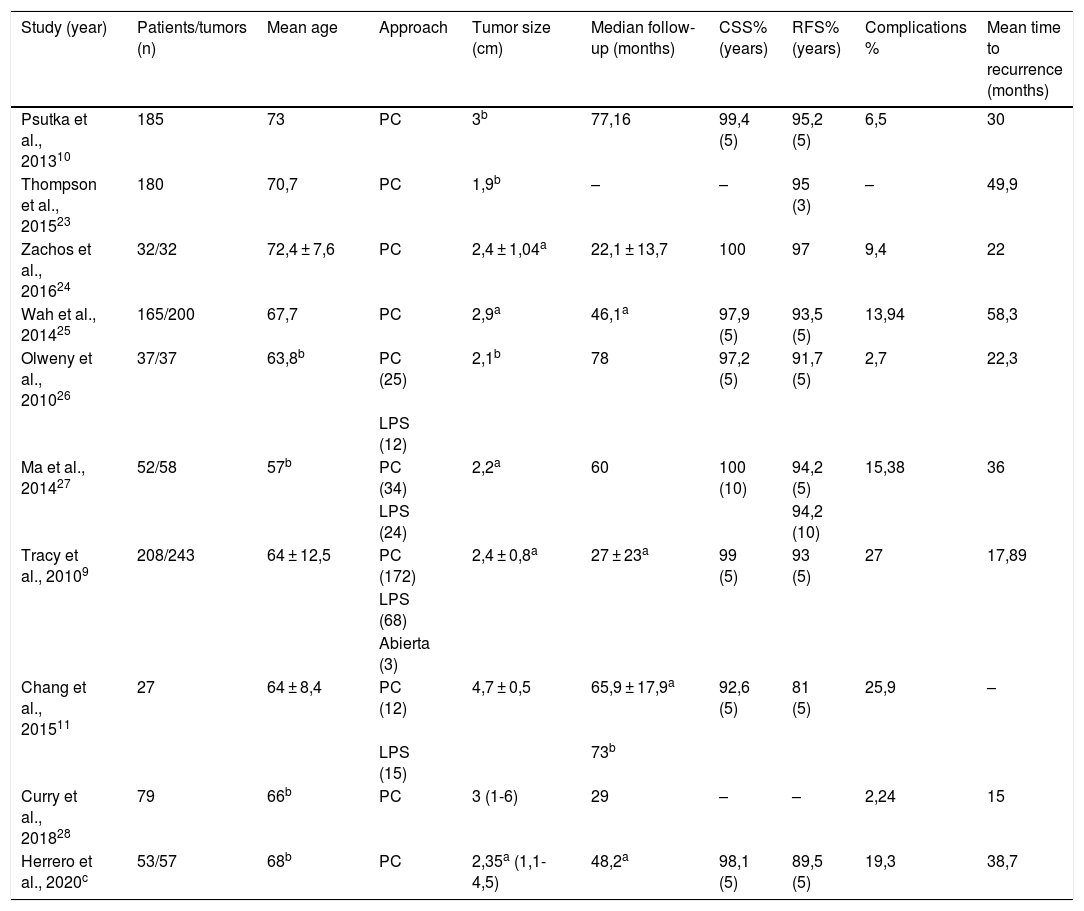The management of renal tumors ≤4 cm in elderly population or patients with comorbidities is a challenge, for which ablative therapies are an interesting alternative. The objective is to evaluate in our center the role of percutaneous radiofrequency in the treatment of small renal masses, the associated complications and the results obtained.
Material and methodsRetrospective evaluation of the radiofrequency treatments carried out between April 2010 and April 2020 in our center. Demographic data, associated comorbidities, tumor characteristics, complications and oncological and functional outcomes were reviewed.
ResultsFifty-seven tumors were treated in 53 patients. Mean follow-up of 48.2 months. The percentage of complete ablations obtained was of 89.5%. There were 19.3% of complications. According to Clavien-Dindo and SIR classification systems, 3.5% and 5.3% were major complications. A statistically significant association was found between the initial result of ablation and age (p = 0.047), RENAL-m (p = 0.044), the presence of cystic component (p = 0.049) and tumor size (p = 0.01). The cut-off point for size was established at 25 mm (p = 0.012). In multivariate analysis, only size remained as a predictor of initial ablation result (p = 0.01 OR = 1.183 CI 95% = 1.041–1.345). Cancer-specific survival and 5-year recurrence-free survival were 98.1% and 89.5%, respectively.
A mean decrease of MDRD-4 of 6.59 mL/min (p = 0.005) was observed in the first 6 months after RFA.
ConclusionsGiven the excellent oncological and functional results demonstrated, ultrasound-guided percutaneous radiofrequency ablation is an effective and safe treatment for small renal masses in selected patients.
El manejo de tumoraciones renales ≤4 cm en población anciana o con comorbilidades supone un reto, constituyendo las terapias ablativas una alternativa interesante. El objetivo es evaluar la radiofrecuencia percutánea en el tratamiento de masas renales pequeñas en nuestro centro, las complicaciones asociadas y los resultados obtenidos.
Material y métodosEvaluación retrospectiva de las radiofrecuencias realizadas entre abril de 2010 y abril de 2020 en nuestro centro. Se revisaron datos demográficos, comorbilidades asociadas, características tumorales, complicaciones y resultados oncológicos y funcionales.
ResultadosSe trataron 57 tumores en 53 pacientes. Seguimiento medio de 48,2 meses. Se obtuvo un 89,5% de ablaciones completas. Hubo un 19,3% de complicaciones. Fueron catalogadas como mayores un 3,5% y un 5,3% según Clavien-Dindo y SIR. Se encontró asociación estadísticamente significativa entre el resultado inicial de la ablación y la edad (p = 0,047), el score RENAL modificado (RENAL-m) (p = 0,044), la presencia de componente quístico (p = 0,049) y el tamaño tumoral (p = 0,01). El punto de corte de tamaño quedó establecido en 25 mm (p = 0,012). En el análisis multivariante, únicamente el tamaño permaneció como predictor de resultado inicial de ablación (p = 0,01; OR 1,183; IC 95% 1,041-1,345). La supervivencia cáncer específica y supervivencia libre de recurrencia a cinco años fueron del 98,1% y del 89,5% respectivamente.
Se observó una disminución media del MDRD-4 de 6,59 mL/min (p = 0,005) en los seis primeros meses tras radiofrecuencia (RFA).
ConclusionesDados los excelentes resultados oncológicos y funcionales demostrados, la radiofrecuencia percutánea guiada por ecografía es una terapia eficaz y segura en el tratamiento de masas renales pequeñas en pacientes seleccionados.





